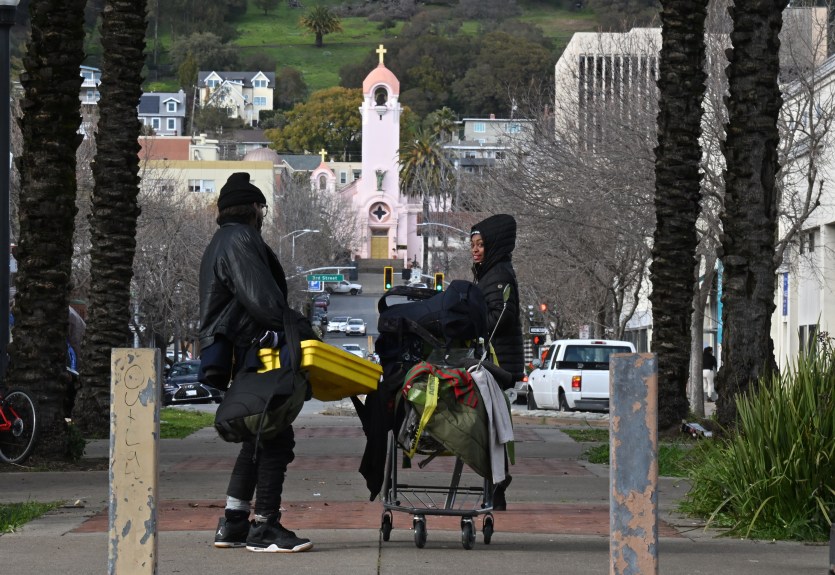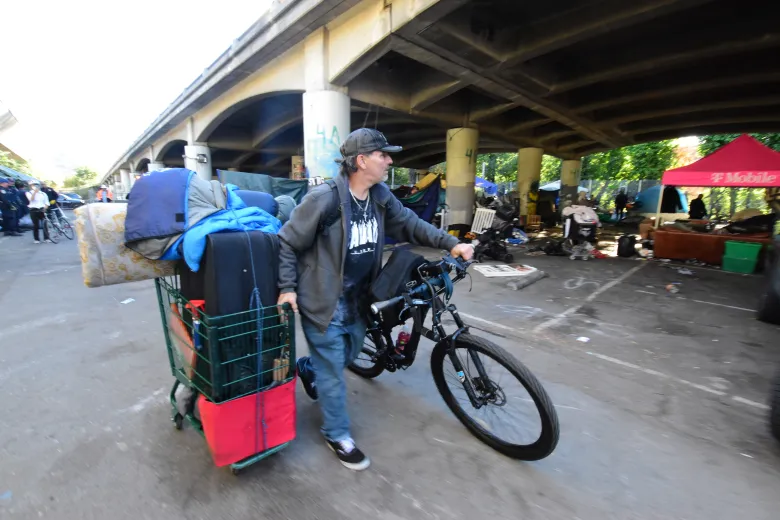
Shardae Barb, right, with Community Action Marin, stops for a chat near a homeless encampment at Albert Park in San Rafael on Tuesday, March 7, 2023. (Sherry LaVars/Marin Independent Journal)
By RICHARD HALSTEAD | rhalstead@marinij.com | Marin Independent Journal
PUBLISHED: | UPDATED:
Marin County, San Rafael and Novato are among 22 jurisdictions in California that have been awarded new state grants to help move homeless campers into housing.
“We’re doubling down on our investment to ensure that thousands of individuals in communities up and down the state move out of encampments and into housing where they can get the services and help they need,” Gov. Gavin Newsom said in announcing the allocations last week.
Marin County was awarded $1.6 million to address a camp of about 90 people living in vehicles along Binford Road in unincorporated Novato. The county and Novato also received another $1.1 million jointly to relocate 45 people from a camp in the Hamilton area. The governor’s announcement also said San Rafael will “receive $250,000 to serve 23 people.”
Statewide, Newsom said, the grants will total $199 million and assist 7,300 homeless campers. The money is the third and largest round of grants distributed as part of the state’s Encampment Resolution Funding program. Twenty-six jurisdictions were awarded $96 million in the first two rounds.
The program is one of the components of Assembly Bill 140, which Newsom signed into law in 2021. According to the state’s application for the grants, the funding is to “support people living in encampments onto paths to safe and stable housing.”
The application also states that program activities must comply with “Housing First” requirements.
The “housing first” approach focuses on getting the chronically homeless residents — people who have been homeless for at least one year and have a physical, mental or substance-used related disability — housed with supportive services.
“The state’s intent is to provide direct assistance to individuals to move them from the encampments to permanent supportive housing,” said Gary Naja-Riese, a county homelessness official. “This grant uses exactly the same housing first model that we do here in Marin. This is the same process that we use with any of our clients.”
Naja-Riese said most of the money will go to pay permanent supportive housing case managers, who are supplied by nonprofits such as Community Action Marin and the Downtown Streets Team.
“Permanent supportive housing case management is a requirement before an individual can be matched with a Section 8 voucher,” Naja-Riese said.
Most people housed in Marin through the housing first model use vouchers issued by the U.S. Department of Housing and Urban Development. The vouchers allow homeless residents to rent privately owned rooms or apartments with the guarantee that they will required to pay no more than 30% of their income for rent. If they have no income, they pay nothing.
Naja-Reise said at least 80 people who will be aided by the new grants will also receive permanent supportive services once they are housed to prevent them from falling back into homelessness.
He said those services cost approximately $595 a month per person, or more than $7,000 a year per person. If just 80 of the 137 people estimated to be served by the two grants were to be housed, the cost of supportive services would amount to more than $1.6 million over the first three years.
Naja-Reise, however, said some of the grant money will also be spent on providing direct services to people living in the camps, such as money for first and last month’s rent and security deposits.
Toni Shroyer, a Novato resident who twice ran for county supervisor, has spoken out several times at recent supervisors’ meetings decrying the vehicle occupants on Binford Road.
“Human waste, trash, toxins, needles and hoarding have gone and are going into our once protected wetlands,” Shroyer wrote in an email Thursday, “and blocking access to the rest of the public who can no longer bike, walk or take photos of the wildlife.”
“The county should be using this $1.6 million like the San Jose mayor,” Shroyer added. “He is finding solutions for housing for the homeless, and we need to pursue his model.”
Last month, San Jose Mayor Matt Mahan proposed reallocating $38 million in city money set aside for permanent affordable housing to interim solutions such as tiny homes, hotel rooms and safe parking sites.
Last week, San Jose’s council voted 10-1 to approve a compromise that will result in the city allocating about $27 million to interim housing.
Naja-Reise said that even though the new grant money coming to Marin won’t expand interim shelter options here, “If individuals are interested in moving from their current encampment site to one of our shelter beds that will absolutely be made available to them.”
But Mary Kay Sweeney, co-director of Homeward Bound of Marin, which provides nearly all of the county’s interim shelter beds, said the program is “completely full at this time.”
Chris Hess, San Rafael’s assistant director of community development, said his city applied for Encampment Resolution Funding money in February to address a camp in Albert Park. That camp, however, was cleared in March when the City Council banned camping there.
Hess said state officials have nevertheless given San Rafael the green light to use the $250,000 it has been awarded to address its ongoing problem with homeless campers.
“We continue to need to serve many of the same individuals who continue camping in our city, just in a different spot,” Hess said.
He said San Rafael used a $522,000 first round grant to house 47 chronically homeless residents, and at last count 31 remained housed.
Hess said San Rafael is investigating the feasibility of creating more interim housing because “encampments are not a good waiting room for housing.”
He said while the new grant money can’t be used to create new interim housing, San Rafael could use it to provide services as part of larger interim housing scheme.

Spencer Emerson heads out of San Rafael’s camp for homeless people on Thursday, Sept. 1, 2022. (Sherry LaVars/Marin Independent Journal)
Used with permission by the Marin Independent Journal.
Read article at the Marin IJ and subscribe to the Marin IJ.
